EPCDescriptor: A Multi-Attribute Visual Network Modeling of Housing Energy Performance
Abstract
1. Introduction
- Introduced a dynamic graph visualisation technique that converts individual dwelling attributes directly into a network framework.
- Proposed a systematic approach for analysing the structural features of houses, emphasising their impact on Energy Performance Certificate (EPC) ratings.
- Introduced a user-focused assessment system that measures the clarity and effectiveness of the interactive graph visualisation.
- Presented comprehensive case studies that demonstrate the implementation of the suggested technique across various EPC grades (A-G).
2. Proposed Framework
2.1. Graph Design Requirement Analysis
2.1.1. Extracting Visual Information
2.1.2. Structural Visual Information
2.2. Abstraction of EPCDescriptor
2.2.1. Visual Information Extraction Module
2.2.2. Visual Structural Generation Module
3. Visual Information Extraction
3.1. Input Data Description of EPCDescriptor
3.1.1. Handling Missing Values and Inconsistencies
3.1.2. Attributes Scaling
- Xscaled is the scaled value of the attribute.
- X is the original value of the attribute.
- Xmin is the minimum value of the attribute in the dataset.
- Xmax is the maximum value of the attribute in the dataset.
3.2. M1: Searching Node Conditions
3.2.1. Searching Attribute Conditions
3.2.2. Attributes Filtering Conditions
3.2.3. Interactive Sorting Conditions
3.3. M2: Searching Node-Link Conditions
3.3.1. Node–Link Structure Conditions
3.3.2. Node–Link Filtering Conditions
3.3.3. Rule-Based Node-Link Weight Calculation
| Algorithm 1: Proportional Rule-Based Edge Weight Calculation |
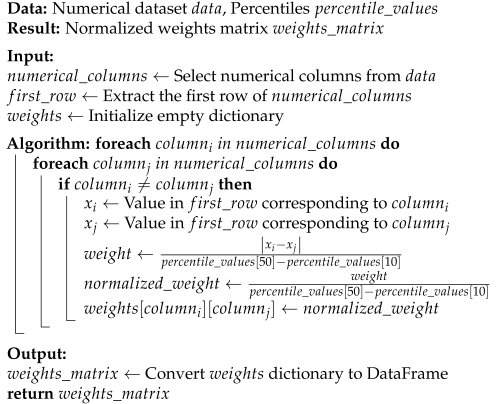 |
3.3.4. Node-Link Weights and Colour Conditions
3.4. M3: Visual Encoding Conditions
3.4.1. Attribute (Node) Level Visual Encoding
3.4.2. Link (Edge) Level Visual Encoding
3.4.3. Data Binding
3.4.4. Structural Level Visual Encoding
3.5. M4: Structural Layout Conditions
3.5.1. Structural Node Position
3.5.2. Structural Edge Positions and Connections
3.5.3. Structural Layouts
4. Visual Structural Information Generation
4.1. House Network Construction and Layout
4.2. Attribute Performance Colour Coding
4.3. Visualisation and Interpretation of Networks
4.4. Interactive Visual Investigation
4.5. Evaluation of Overall Performance for EPC Ratings
5. Case Studies
5.1. Case 1: EPC A-Outstanding Energy Performance
5.1.1. Node-Link Conditions
5.1.2. Visual Encoding Conditions
5.1.3. Structural Layout Conditions
5.1.4. Interactive Visual Interaction
5.2. Case 1: EPC B-Above Average Energy Performance
5.2.1. Node–Link Conditions
5.2.2. Visual Encoding Conditions
5.2.3. Structural Layout Conditions
5.2.4. Interactive Visual Interaction
5.3. Case 2: EPC C-Moderate Energy Performance
5.3.1. Node-Link Conditions
5.3.2. Visual Encoding Conditions
5.3.3. Structural Layout Conditions
5.3.4. Interactive Visual Interaction
5.4. Case 3: EPC E-Insufficient Energy Performance
5.4.1. Node-Link Conditions
5.4.2. Visual Encoding Conditions
5.4.3. Structural Layout Conditions
5.4.4. Interactive Visual Interaction
6. Evaluation Study
6.1. Objective
6.2. Participants
6.2.1. Specialists (P1–P3):
6.2.2. Visualisation Experts (P4–P6):
6.2.3. Users (P7–P16):
6.3. Tasks
6.4. Action to Take
6.5. Results
6.5.1. Clarity
6.5.2. Aesthetic
6.5.3. Practicality
7. Discussion
7.1. Significance
7.2. Scalability
7.3. Limitation
7.4. Future Work
8. Conclusions
Author Contributions
Funding
Institutional Review Board Statement
Data Availability Statement
Acknowledgments
Conflicts of Interest
References
- Jenkins, D.; Semple, S.; Patidar, S.; McCallum, P. Changing the approach to energy compliance in residential buildings–re-imagining EPCs. Energy Build. 2021, 249, 111239. [Google Scholar] [CrossRef]
- Crawley, J.; Biddulph, P.; Northrop, P.J.; Wingfield, J.; Oreszczyn, T.; Elwell, C. Quantifying the measurement error on England and Wales EPC ratings. Energies 2019, 12, 3523. [Google Scholar] [CrossRef]
- Pasichnyi, O.; Wallin, J.; Levihn, F.; Shahrokni, H.; Kordas, O. Energy performance certificates—New opportunities for data-enabled urban energy policy instruments? Energy Policy 2019, 127, 486–499. [Google Scholar] [CrossRef]
- Li, Y.; Kubicki, S.; Guerriero, A.; Rezgui, Y. Review of building energy performance certification schemes towards future improvement. Renew. Sustain. Energy Rev. 2019, 113, 109244. [Google Scholar] [CrossRef]
- Shakeel, H.M.; Iram, S.; Hill, R.; Athar Farid, H.M.; Sheikh-Akbari, A.; Saleem, F. A Machine Learning-Based Intelligent Framework for Predicting Energy Efficiency in Next-Generation Residential Buildings. Buildings 2025, 15, 1275. [Google Scholar] [CrossRef]
- Nield, S. Net Zero Homes: Time for a Reset, The English Story. 2023. Available online: https://diposit.ub.edu/dspace/bitstream/2445/203173/1/6.%20WP%20Sarah%20Nield_2023_6.pdf (accessed on 16 August 2025).
- Ahern, C.; Norton, B. Energy Performance Certification: Misassessment due to assuming default heat losses. Energy Build. 2020, 224, 110229. [Google Scholar] [CrossRef]
- Webborn, E.; McKenna, E.; Elam, S.; Anderson, B.; Cooper, A.; Oreszczyn, T. Increasing response rates and improving research design: Learnings from the Smart Energy Research Lab in the United Kingdom. Energy Res. Soc. Sci. 2022, 83, 102312. [Google Scholar] [CrossRef]
- Shakeel, H.M.; Iram, S.; Hill, R.; Farid, H.M.A.; Brown, P.; Rehman, H.U. An XAI-Driven Diagnostic Framework to Investigate the Predictive Power of Building Features to Enhance EPC Ratings in Detached Houses. Energy Build. 2025, 344, 116022. [Google Scholar] [CrossRef]
- Li, X.; Gao, X.; Wang, Q.; Wang, C.; Li, B.; Wan, K. Feature Analysis Network: An Interpretable Idea in Deep Learning. Cogn. Comput. 2024, 16, 803–826. [Google Scholar] [CrossRef]
- Luo, T.; Zhu, C.; Li, B.; Shen, X.; Zhu, G. Feature analysis aided design of lightweight heat sink from network structures. iScience 2025, 28, 111630. [Google Scholar] [CrossRef]
- Bick, C.; Gross, E.; Harrington, H.A.; Schaub, M.T. What are higher-order networks? SIAM Rev. 2023, 65, 686–731. [Google Scholar] [CrossRef]
- Kundu, S.; Datta, G.; Pedram, M.; Beerel, P.A. Spike-thrift: Towards energy-efficient deep spiking neural networks by limiting spiking activity via attention-guided compression. In Proceedings of the IEEE/CVF Winter Conference on Applications of Computer Vision, Virtual, 5–9 January 2021; pp. 3953–3962. [Google Scholar]
- Han, S.; Mao, H.; Dally, W.J. Deep compression: Compressing deep neural networks with pruning, trained quantization and huffman coding. arXiv 2015, arXiv:1510.00149. [Google Scholar] [CrossRef]
- La Rosa, B.; Blasilli, G.; Bourqui, R.; Auber, D.; Santucci, G.; Capobianco, R.; Bertini, E.; Giot, R.; Angelini, M. State of the art of visual analytics for explainable deep learning. In Proceedings of the Computer Graphics Forum; Wiley Online Library: Hoboken, NJ, USA, 2023; Volume 42, pp. 319–355. [Google Scholar] [CrossRef]
- Zhou, G.; Ewald, J.; Xia, J. OmicsAnalyst: A comprehensive web-based platform for visual analytics of multi-omics data. Nucleic Acids Res. 2021, 49, W476–W482. [Google Scholar] [CrossRef]
- Zhou, G.; Pang, Z.; Lu, Y.; Ewald, J.; Xia, J. OmicsNet 2.0: A web-based platform for multi-omics integration and network visual analytics. Nucleic Acids Res. 2022, 50, W527–W533. [Google Scholar] [CrossRef] [PubMed]
- Wang, H.; Lu, Y.; Shutters, S.T.; Steptoe, M.; Wang, F.; Landis, S.; Maciejewski, R. A visual analytics framework for spatiotemporal trade network analysis. IEEE Trans. Vis. Comput. Graph. 2018, 25, 331–341. [Google Scholar] [CrossRef]
- Wang, J.; Gou, L.; Shen, H.; Yang, H. DQNViz: A Visual Analytics Approach to Understand Deep Q-Networks. IEEE Trans. Vis. Comput. Graph. 2020, 26, 288–298. [Google Scholar] [CrossRef]
- Sacha, D.; Kraus, M.; Keim, D.A.; Chen, M. VIS4ML: An Ontology for Visual Analytics Assisted Machine Learning. Data Knowl. Eng. 2017, 108, 1–20. [Google Scholar] [CrossRef]
- Shakeel, H.M.; Iram, S.; Al-Aqrabi, H.; Alsboui, T.; Hill, R. A comprehensive state-of-the-art survey on data visualization tools: Research developments, challenges and future domain specific visualization framework. IEEE Access 2022, 10, 96581–96601. [Google Scholar] [CrossRef]
- Raman, R.; Buddhi, D.; Lakhera, G.; Gupta, Z.; Joshi, A.; Saini, D. An investigation on the role of artificial intelligence in scalable visual data analytics. In Proceedings of the 2023 International Conference on Artificial Intelligence and Smart Communication (AISC), Greater Noida, India, 27–29 January 2023; pp. 666–670. [Google Scholar] [CrossRef]
- Jiao, P. Research on electronic decision system for effective data visualization and analysis process. Comput. Electr. Eng. 2022, 98, 107737. [Google Scholar] [CrossRef]
- Park, H.; Bellamy, M.A.; Basole, R.C. Visual analytics for supply network management: System design and evaluation. Decis. Support Syst. 2016, 91, 89–102. [Google Scholar] [CrossRef]
- Saqhib, M.N.; Lakshmikanth, S. Augmenting relay node selection for improved energy efficiency in non-hierarchical IoT-oriented wireless sensor networks using Q-learning and fuzzy logic. Comput. Electr. Eng. 2025, 123, 110068. [Google Scholar] [CrossRef]
- Pan, J.; Yan, Z.; Zhou, Z.; Zhao, X.; Cheng, S.; Han, D.; Chen, J.; Xu, M.; Chen, W. GraphDescriptor: Augmenting Node-Link Diagrams With Textual Descriptions. In Proceedings of the 2023 IEEE 16th Pacific Visualization Symposium (PacificVis), Seoul, Republic of Korea, 18–21 April 2023; pp. 177–186. [Google Scholar] [CrossRef]
- Liu, X.; Li, X.; Fiumara, G.; De Meo, P. Link prediction approach combined graph neural network with capsule network. Expert Syst. Appl. 2023, 212, 118737. [Google Scholar] [CrossRef]
- Pister, A.; Prieur, C.; Fekete, J.D. ComBiNet: Visual Query and Comparison of Bipartite Multivariate Dynamic Social Networks. In Proceedings of the Computer Graphics Forum; Wiley Online Library: Hoboken, NJ, USA, 2023; Volume 42, pp. 290–304. [Google Scholar] [CrossRef]
- Fuerst, F.; McAllister, P.; Nanda, A.; Wyatt, P. Energy performance ratings and house prices in Wales: An empirical study. Energy Policy 2016, 92, 20–33. [Google Scholar] [CrossRef]
- Shakeel, H.M.; Farid, H.M.A.; Iram, S.; Hill, R.; Simic, V. Multi-stage decision support system for evaluating visual energy performance certificate platforms. Sustain. Energy Grids Netw. 2025, 43, 101767. [Google Scholar] [CrossRef]
- Lomas, K.; Beizaee, A.; Allinson, D.; Haines, V.; Beckhelling, J.; Loveday, D.; Porritt, S.; Mallaband, B.; Morton, A. A domestic operational rating for UK homes: Concept, formulation and application. Energy Build. 2019, 201, 90–117. [Google Scholar] [CrossRef]
- Department for Levelling Up, Housing & Communities. Energy Performance of Buildings Data: England and Wales. 2023. Available online: https://epc.opendatacommunities.org/ (accessed on 14 November 2023).
- Iram, S.; Fernando, T.; Bassanino, M. Exploring Cross-Domain Data Dependencies for Smart Homes to Improve Energy Efficiency. In Proceedings of the Companion Proceedings of the 10th International Conference on Utility and Cloud Computing, New York, NY, USA, 5–8 December 2017; UCC’17 Companion. pp. 221–226. [Google Scholar] [CrossRef]
- Patro, S.; Sahu, K.K. Normalization: A preprocessing stage. arXiv 2015, arXiv:1503.06462. [Google Scholar] [CrossRef]
- Maharani, W.; Gozali, A.A. Degree centrality and eigenvector centrality in twitter. In Proceedings of the 2014 8th International Conference on tElecommunication Systems Services and Applications (TSSA), Kuta, Indonesia, 23–24 October 2014; pp. 1–5. [Google Scholar] [CrossRef]
- Brandes, U. A faster algorithm for betweenness centrality. J. Math. Sociol. 2001, 25, 163–177. [Google Scholar] [CrossRef]
- Sarma, A.D.; Gollapudi, S.; Panigrahy, R. Estimating pagerank on graph streams. J. ACM 2011, 58, 1–19. [Google Scholar] [CrossRef]
- Kobourov, S.G. Spring embedders and force directed graph drawing algorithms. arXiv 2012, arXiv:1201.3011. [Google Scholar] [CrossRef]
- Iram, S.; Fernando, T.; Hill, R. Connecting to Smart Cities: Analyzing Energy Times Series to Visualize Monthly Electricity Peak Load in Residential Buildings. In Proceedings of the Future Technologies Conference (FTC) 2018; Arai, K., Bhatia, R., Kapoor, S., Eds.; Springer: Cham, Switzerland, 2019; pp. 333–342. [Google Scholar] [CrossRef]
- Anđelković, A.S.; Kljajić, M.; Macura, D.; Munćan, V.; Mujan, I.; Tomić, M.; Vlaović, Ž.; Stepanov, B. Building energy performance certificate—A relevant indicator of actual energy consumption and savings? Energies 2021, 14, 3455. [Google Scholar] [CrossRef]
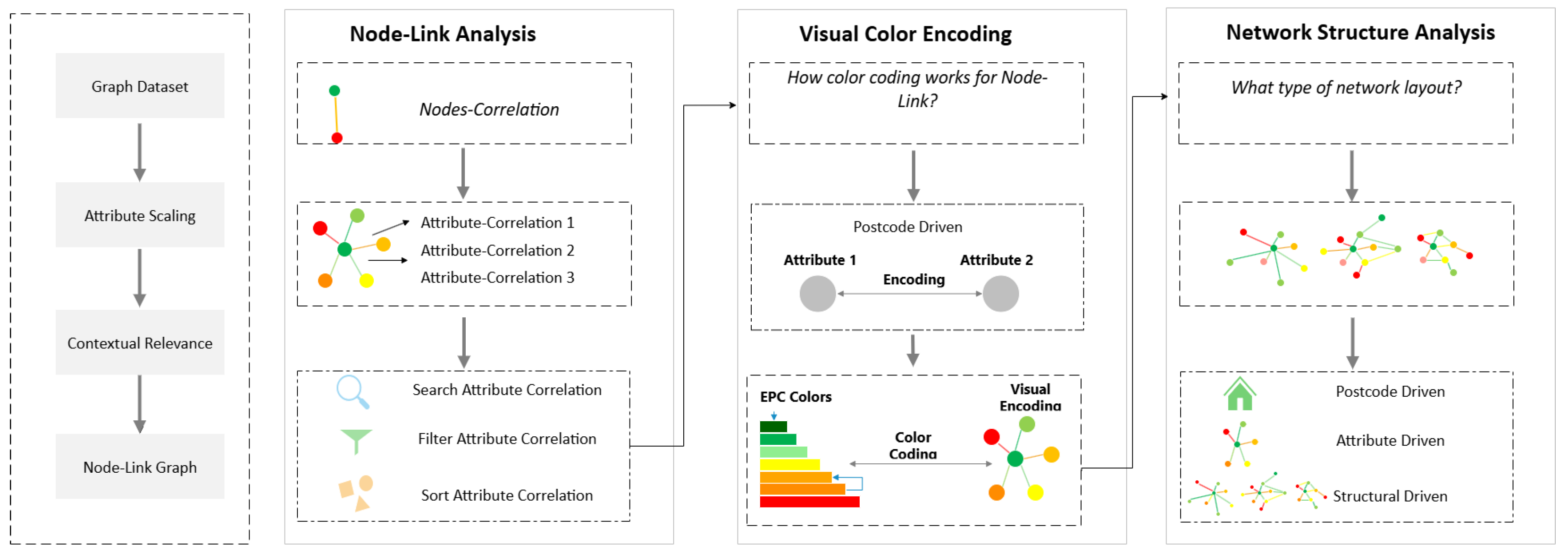

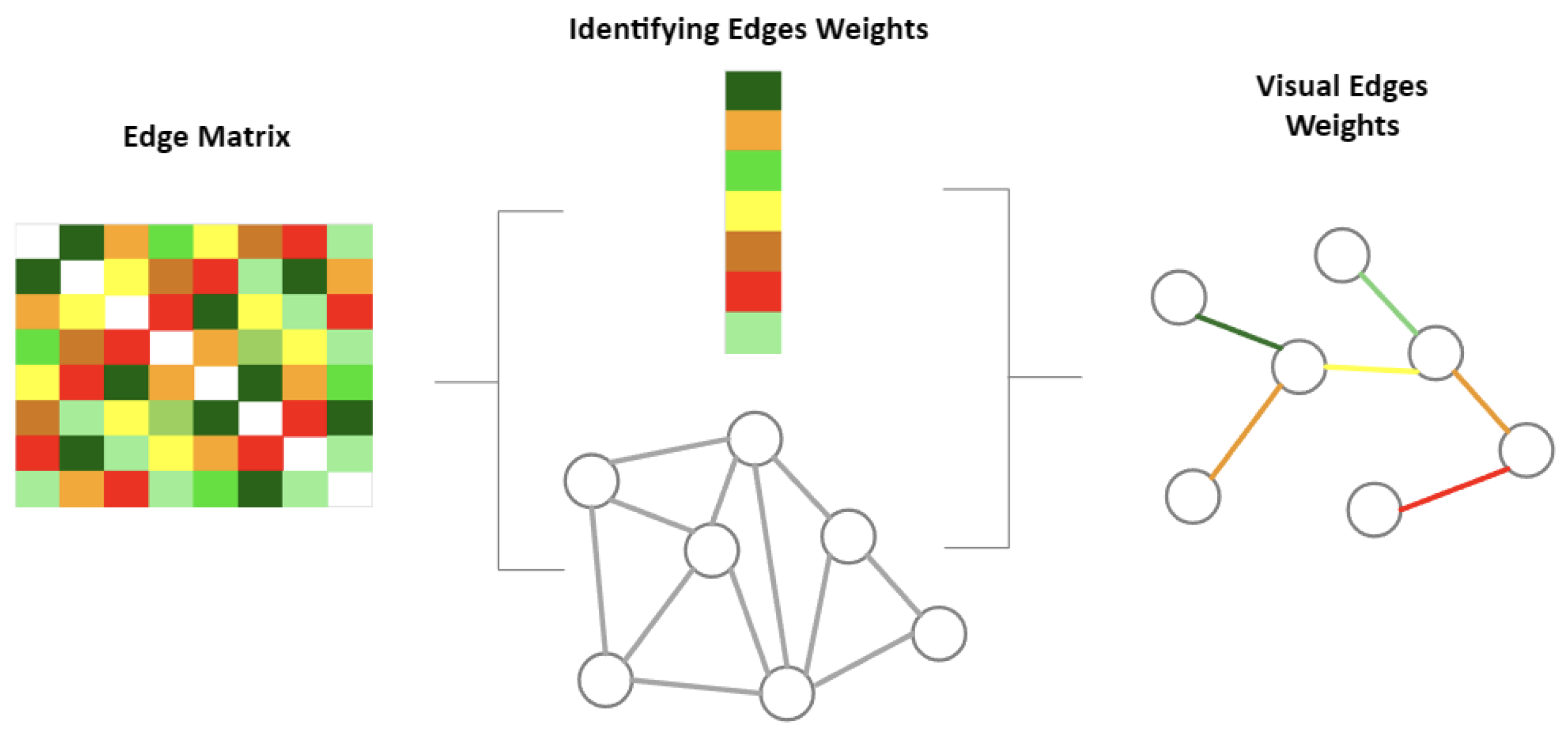
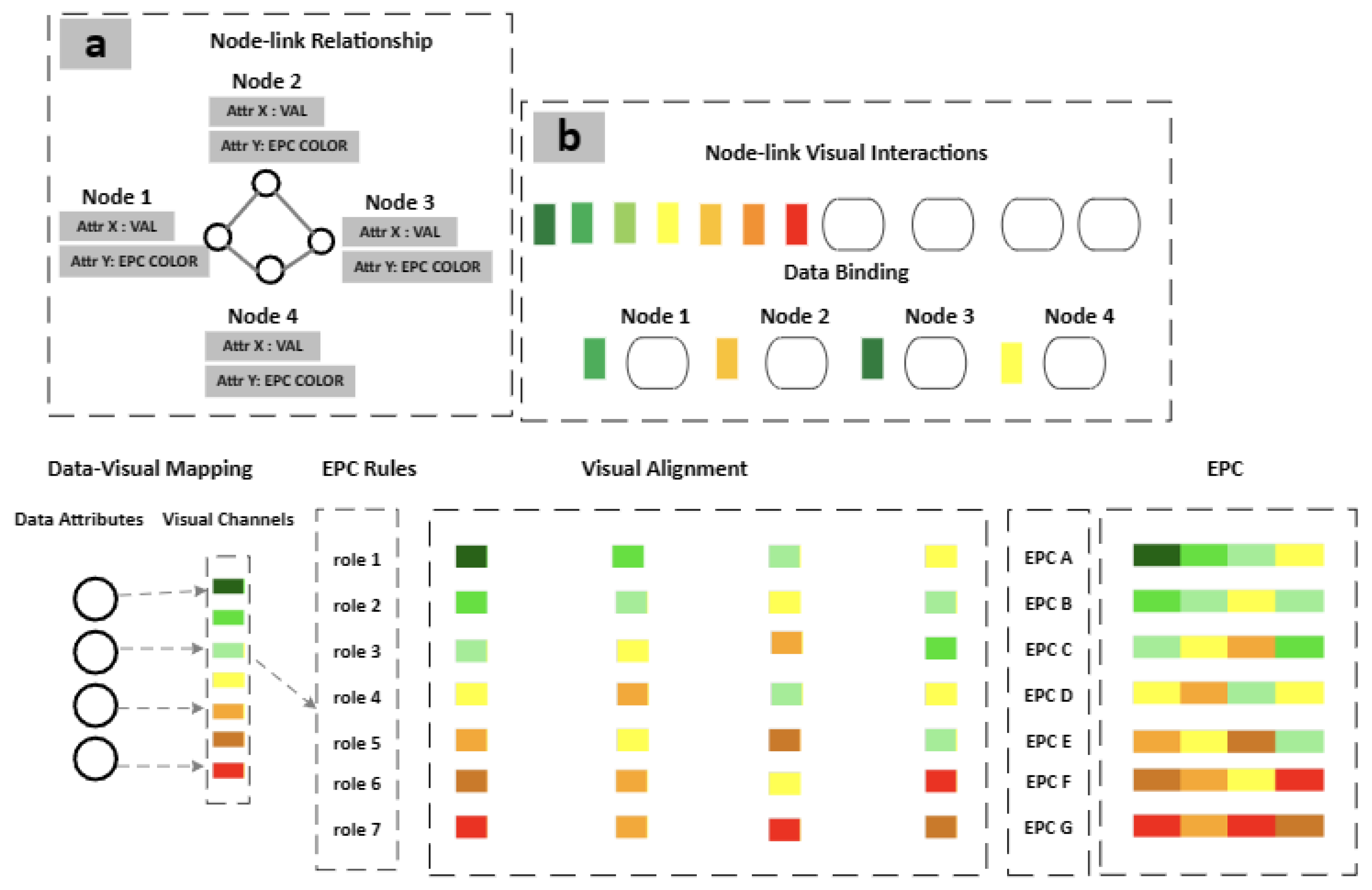
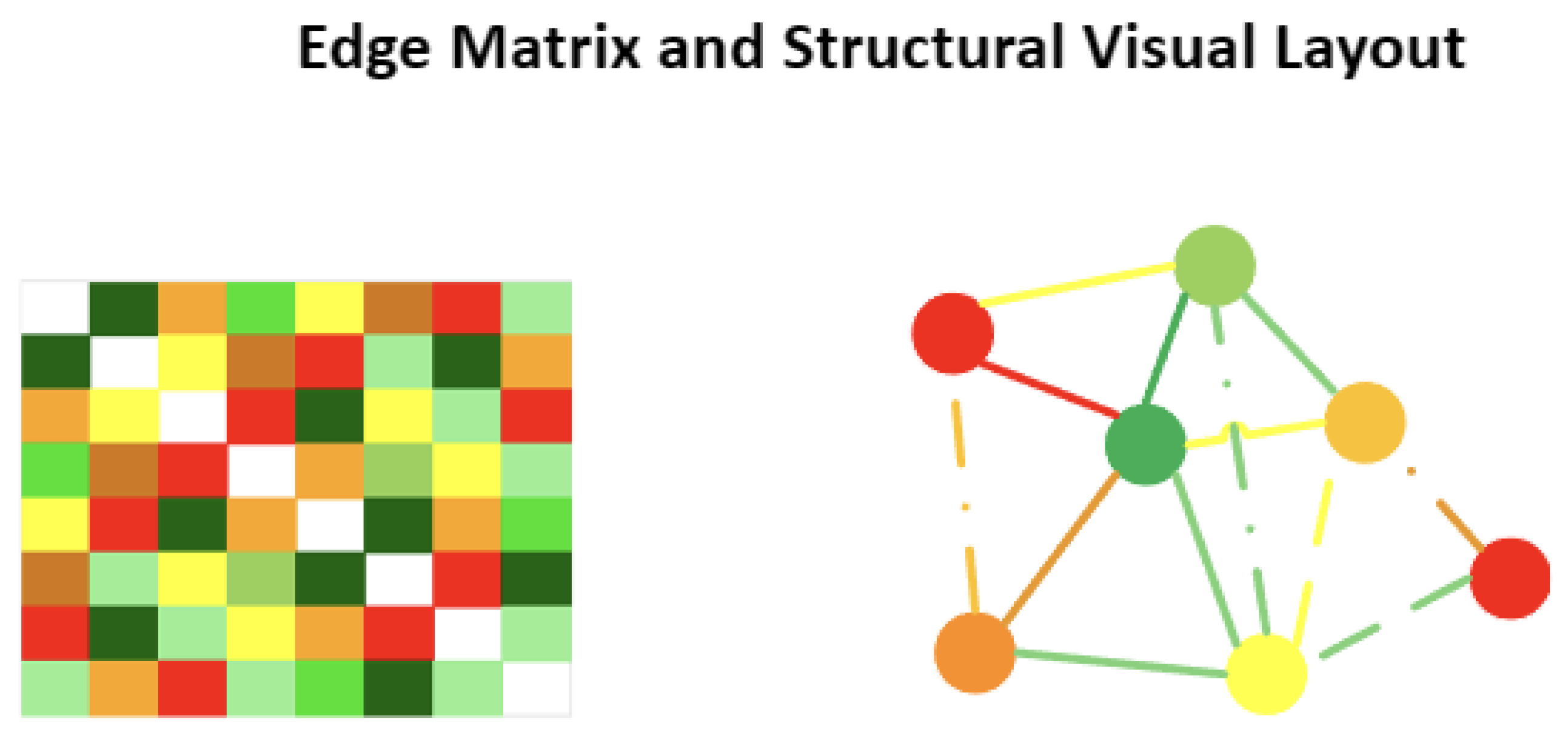

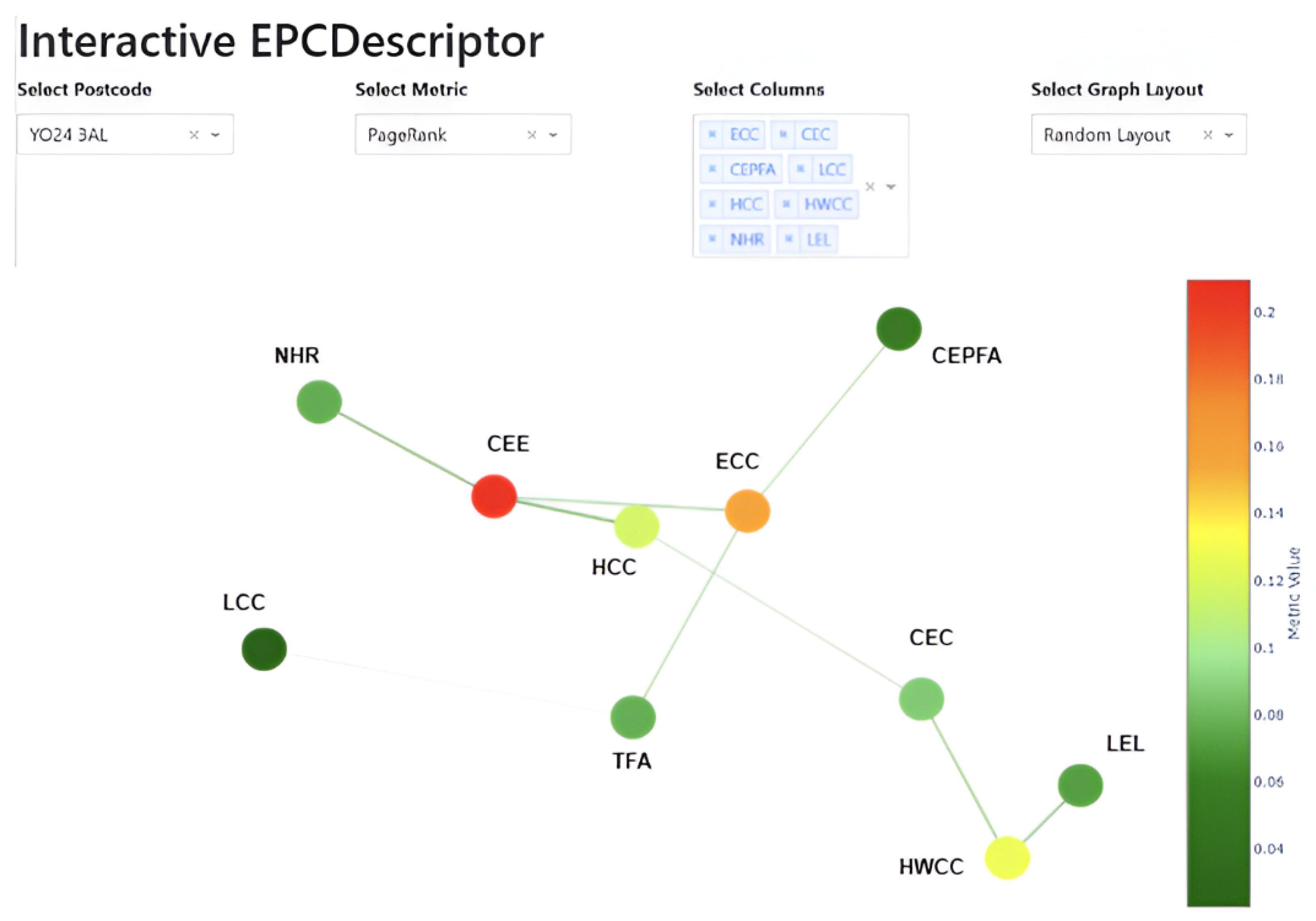
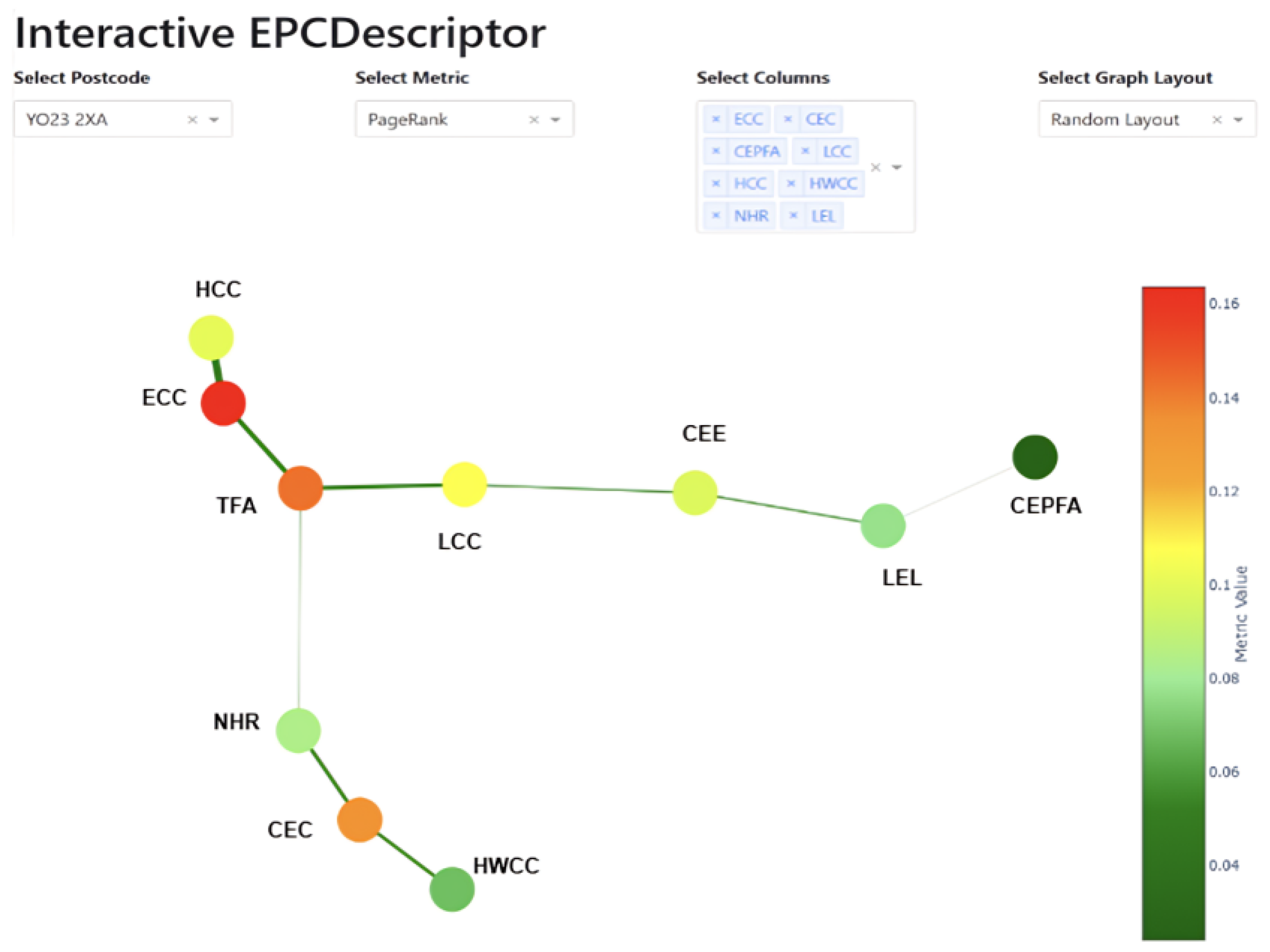
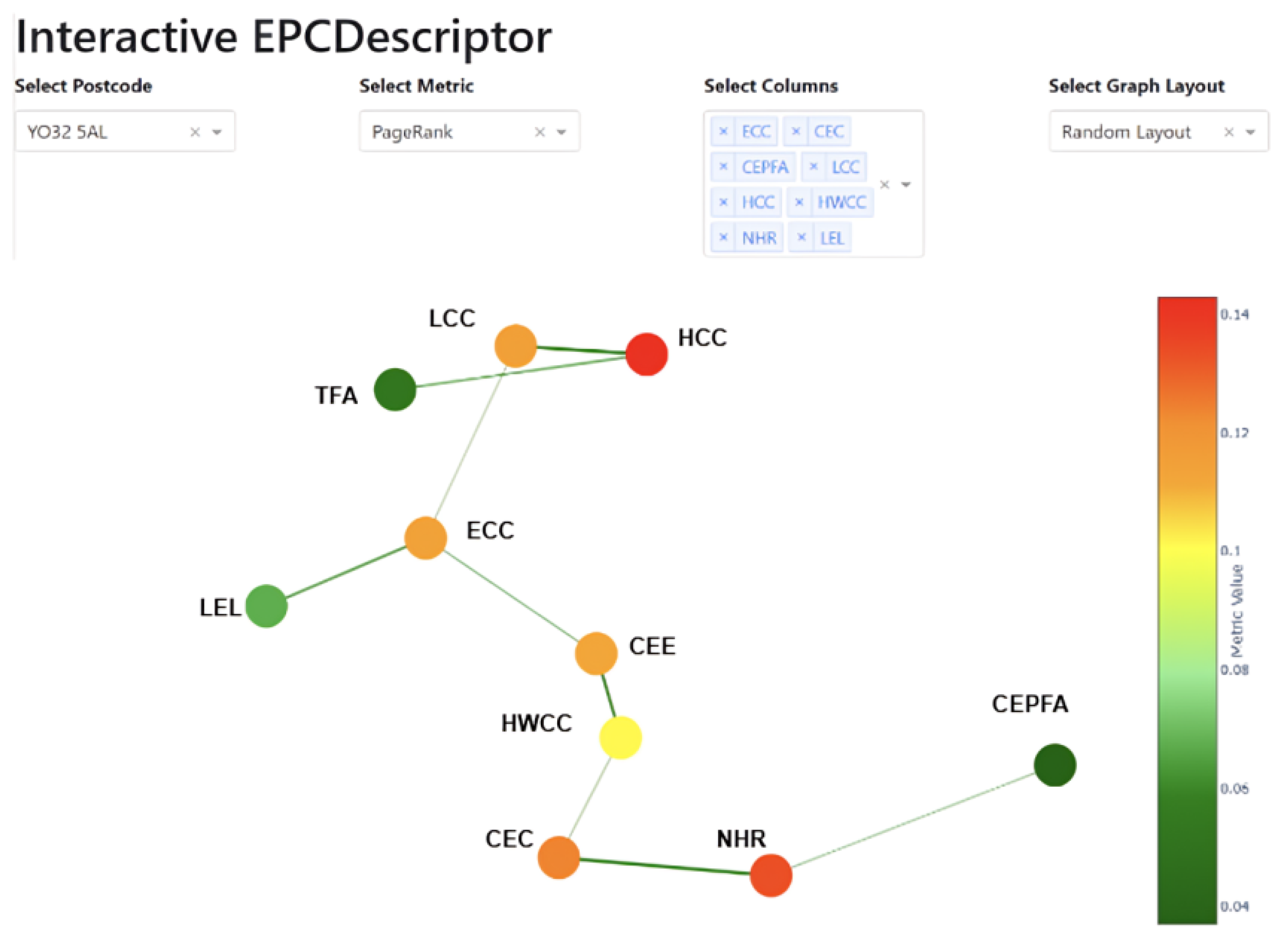
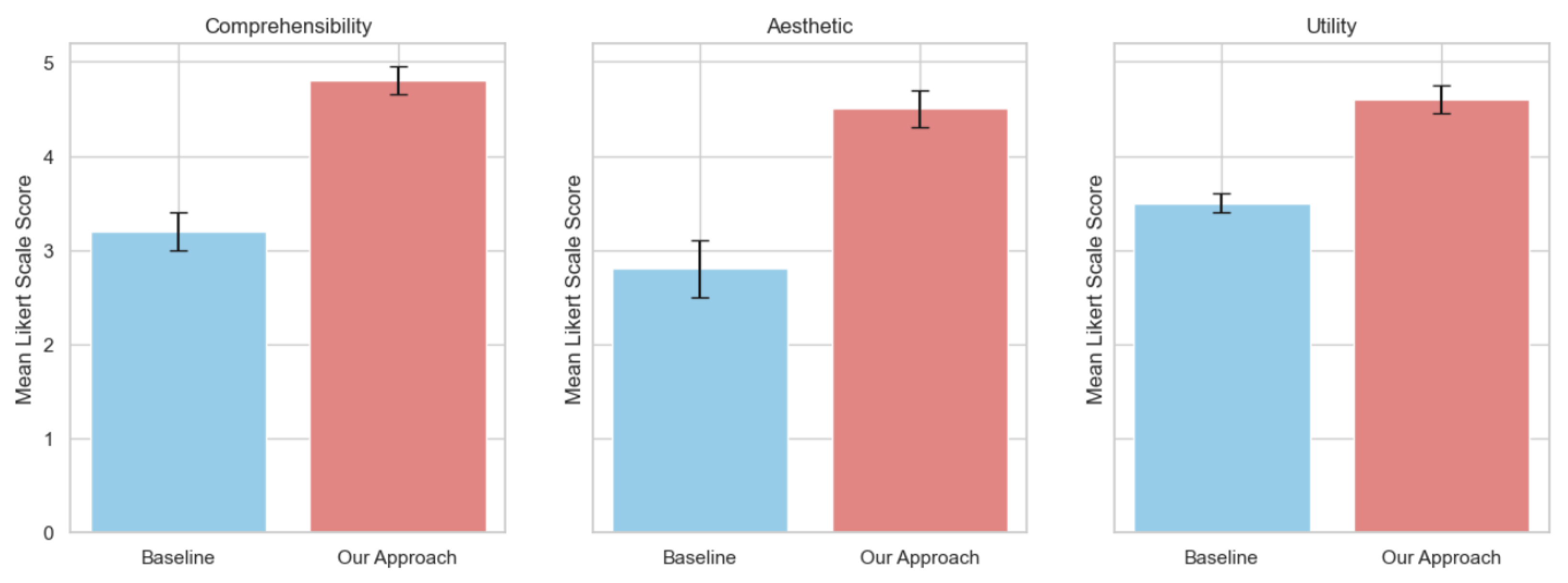
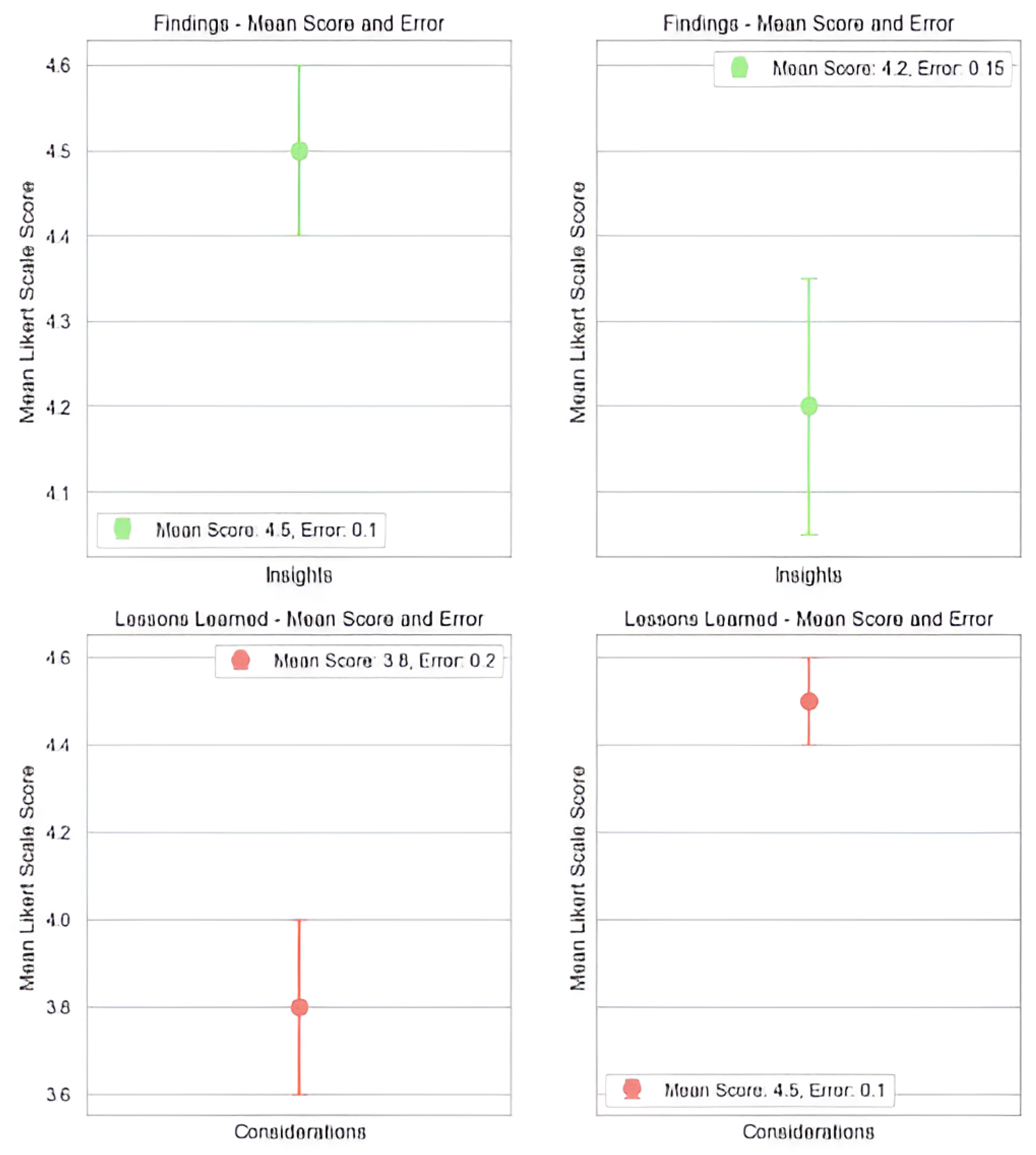
| Total Houses (Before Cleaning) | Total Houses (After Cleaning) | EPC Rating | Number of Houses (As per EPC) | Numerical Attributes | Acronym |
|---|---|---|---|---|---|
| 49,959 | 36,540 | A | 20 | Energy Consumption Current | ECC |
| B | 458 | CO2 Emissions Current | CEC | ||
| C | 11,099 | CO2 Emissions Curr Per Floor Area | CEPFA | ||
| D | 19,482 | Lighting Cost Current | LCC | ||
| E | 4599 | Heating Cost Current | HCC | ||
| F | 732 | Hot Water Cost Current | HWCC | ||
| G | 150 | Total Floor Area | TFA | ||
| Number Habitable Rooms | NAR | ||||
| Number Heated Rooms | NHR | ||||
| Low Energy Lighting | LEL |
| Numerical Attributes | Unit |
|---|---|
| Energy Consumption Current | Kilowatt-hours (kWh) |
| CO2 Emissions Current | Kilograms of carbon dioxide (kg CO2) |
| CO2 Emissions Curr Per Floor Area | Kilograms of carbon dioxide per square meter (kg CO2/m2) |
| Lighting Cost Current | Currency per unit time |
| Heating Cost Current | Currency per unit time |
| Hot Water Cost Current | Currency per unit time |
| Total Floor Area | Square meters (m2) |
| Number Habitable Rooms | Count |
| Number Heated Rooms | Count |
| Low Energy Lighting | Count |
| Attribute | EPC A | EPC B | EPC C | EPC E |
|---|---|---|---|---|
| ENERGY_CONSUMPTION_CURRENT (kWh/m2·yr) | 9 | 77 | 305 | 504 |
| CURRENT_ENERGY_EFFICIENCY (%) | 95 | 84 | 69 | 43 |
| CO2_EMISSIONS_CURRENT (kgCO2/yr) | 0.3 | 1.2 | 2.5 | 5.9 |
| TOTAL_FLOOR_AREA (m2) | 134 | 168 | 48 | 70 |
| LOW_ENERGY_LIGHTING (% rooms) | 100 | 100 | 60 | 60 |
Disclaimer/Publisher’s Note: The statements, opinions and data contained in all publications are solely those of the individual author(s) and contributor(s) and not of MDPI and/or the editor(s). MDPI and/or the editor(s) disclaim responsibility for any injury to people or property resulting from any ideas, methods, instructions or products referred to in the content. |
© 2025 by the authors. Licensee MDPI, Basel, Switzerland. This article is an open access article distributed under the terms and conditions of the Creative Commons Attribution (CC BY) license (https://creativecommons.org/licenses/by/4.0/).
Share and Cite
Shakeel, H.M.; Iram, S.; Farid, H.M.A.; Hill, R.; Rehman, H.u. EPCDescriptor: A Multi-Attribute Visual Network Modeling of Housing Energy Performance. Buildings 2025, 15, 2929. https://doi.org/10.3390/buildings15162929
Shakeel HM, Iram S, Farid HMA, Hill R, Rehman Hu. EPCDescriptor: A Multi-Attribute Visual Network Modeling of Housing Energy Performance. Buildings. 2025; 15(16):2929. https://doi.org/10.3390/buildings15162929
Chicago/Turabian StyleShakeel, Hafiz Muhammad, Shamaila Iram, Hafiz Muhammad Athar Farid, Richard Hill, and Hassam ur Rehman. 2025. "EPCDescriptor: A Multi-Attribute Visual Network Modeling of Housing Energy Performance" Buildings 15, no. 16: 2929. https://doi.org/10.3390/buildings15162929
APA StyleShakeel, H. M., Iram, S., Farid, H. M. A., Hill, R., & Rehman, H. u. (2025). EPCDescriptor: A Multi-Attribute Visual Network Modeling of Housing Energy Performance. Buildings, 15(16), 2929. https://doi.org/10.3390/buildings15162929








